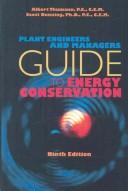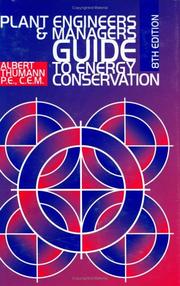| Listing 1 - 10 of 35 | << page >> |
Sort by
|
Book
ISBN: 1634830636 9781634830638 9781634830225 1634830229 Year: 2015 Publisher: Hauppauge, New York : Nova Science Publishers, Incorporated,
Abstract | Keywords | Export | Availability | Bookmark
 Loading...
Loading...Choose an application
- Reference Manager
- EndNote
- RefWorks (Direct export to RefWorks)
Milling machinery. --- Mills and mill-work. --- Grinding and polishing. --- Buffing --- Lapping --- Polishing --- Machining --- Surface preparation --- Industrial arts --- Manufacturing processes --- Technology --- Factories --- Milling machinery --- Pulverizers --- Machinery --- Mills and mill-work --- Millwrights
Book
ISBN: 1438444710 9781438444710 9781438444703 9781438444710 1438444702 Year: 2012 Publisher: Albany Excelsior Editions/State University of New York Press
Abstract | Keywords | Export | Availability | Bookmark
 Loading...
Loading...Choose an application
- Reference Manager
- EndNote
- RefWorks (Direct export to RefWorks)
A young man's quest to keep his hometown's paper mill from closing turns into an odyssey across a rural upstate New York county.
Paper mills --- Factories, Paper --- Paper factories --- Mills and mill-work --- Wood-pulp industry --- Pulp mills --- New York (N.Y.)
Book
ISBN: 9781621000129 1621000125 9781614709039 1614709033 Year: 2012 Publisher: New York
Abstract | Keywords | Export | Availability | Bookmark
 Loading...
Loading...Choose an application
- Reference Manager
- EndNote
- RefWorks (Direct export to RefWorks)
Grinding and polishing. --- Mills and mill-work. --- Industrial arts --- Manufacturing processes --- Technology --- Factories --- Milling machinery --- Buffing --- Lapping --- Polishing --- Machining --- Surface preparation
Book
ISBN: 0817382879 9780817382872 0817316965 9780817316969 0817355928 9780817355920 9780817316969 9780817355920 Year: 2010 Publisher: Tuscaloosa University of Alabama Press
Abstract | Keywords | Export | Availability | Bookmark
 Loading...
Loading...Choose an application
- Reference Manager
- EndNote
- RefWorks (Direct export to RefWorks)
A look at the antebellum history and architecture of the little-known sugar industry of East Florida. From the late eighteenth century to early 1836, the heart of the Florida sugar industry was concentrated in East Florida, between the St. Johns River and the Atlantic Ocean. Producing the sweetest sugar, molasses, and rum, at least 22 sugar plantations dotted the coastline by the 1830's. This industry brought prosperity to the region-employing farm hands, slaves, architects, stone masons, riverboats and their crews, shop keepers, and me
Sugar plantations --- Sugarcane industry --- Mills and mill-work --- Architecture, Industrial --- Masonry --- Historic buildings --- Historic sites --- Industrial archaeology --- History. --- East Florida --- History, Local. --- Antiquities.
Book
ISBN: 1588383881 9781588383884 9781588383877 Year: 2019 Publisher: Montgomery
Abstract | Keywords | Export | Availability | Bookmark
 Loading...
Loading...Choose an application
- Reference Manager
- EndNote
- RefWorks (Direct export to RefWorks)
"It is difficult to imagine a locale more quintessentially American than a Southern mill town. Congeniality, manners, friendliness, and compassion abound; white clapboard houses with black asphalt roofs and neat yards wander down from textile mills and schools. A Mill Village Story is a first-person narrative reflecting the best years of the mill villages in the Chattahoochee River Valley: West Point, Lanett, and Valley. It is a view through the eyes and mind of Gerald Andrews, a hard-scrabble kid who was born at home in a two-room house in Fairfax at the end of the Great Depression and grew up in his grandmother's boarding house. Andrews's creativity and innovative mind aided him in adventures through school, college, relationships, mill work, management, and leadership positions. What comes through most clearly in these pages is his genuine love for the people and how the culture of this nearly lost place shaped him"--
Villages --- Mills and mill-work --- Company towns --- Textile industry --- History --- Andrews, Gerald B. --- Childhood and youth. --- Chattahoochee River Valley --- History, Local.

ISBN: 0881735566 9780881735567 Year: 2008 Publisher: Lilburn, GA Boca Raton, FL Fairmont Press :CRC Press Distributed by Taylor & Francis
Abstract | Keywords | Export | Availability | Bookmark
 Loading...
Loading...Choose an application
- Reference Manager
- EndNote
- RefWorks (Direct export to RefWorks)
Factories --- Mechanical Engineering --- Engineering & Applied Sciences --- Mechanical Engineering - General --- Factory buildings --- Industrial plants --- Manufacturing plants --- Mills (Buildings) --- Plants (Industrial buildings) --- Factory system --- Industrial buildings --- Mills and mill-work --- Workshops --- Energy conservation

ISBN: 9786610208876 0881733849 9780881733846 0824755952 9780824755959 9780881733600 0881733601 0130676195 9780130676191 082470925X 9780824709259 0881733601 Year: 2002 Publisher: Lilburn, GA Fairmont Press
Abstract | Keywords | Export | Availability | Bookmark
 Loading...
Loading...Choose an application
- Reference Manager
- EndNote
- RefWorks (Direct export to RefWorks)
Factories --- Mechanical Engineering --- Engineering & Applied Sciences --- Mechanical Engineering - General --- Factory buildings --- Industrial plants --- Manufacturing plants --- Mills (Buildings) --- Plants (Industrial buildings) --- Factory system --- Industrial buildings --- Mills and mill-work --- Workshops --- Energy conservation
Book
ISBN: 3960677103 9783960677109 9783960672104 3960672101 Year: 2018 Publisher: Hamburg
Abstract | Keywords | Export | Availability | Bookmark
 Loading...
Loading...Choose an application
- Reference Manager
- EndNote
- RefWorks (Direct export to RefWorks)
Electric metal-cutting. --- Milling machinery. --- Milling (Metal-work) --- Metal-cutting --- Metal-work --- Pulverizers --- Machinery --- Mills and mill-work --- Millwrights --- Electric discharge machining --- Electric machining --- Electric spark machining --- Spark-erosion machining
Book
ISBN: 9780081025086 0081025084 9780081025079 0081025076 Year: 2018 Publisher: Amsterdam, Netherlands : Elsevier,
Abstract | Keywords | Export | Availability | Bookmark
 Loading...
Loading...Choose an application
- Reference Manager
- EndNote
- RefWorks (Direct export to RefWorks)
Energy Management in Plastics Processing: Strategies, Targets, Techniques, and Tools, Third Edition, addresses energy benchmarking and site surveys, how to understand energy supplies and bills, and how to measure and manage energy usage and carbon footprinting. The book's approach highlights the need to reduce the kWh/kg of materials processed and the resulting permanent reductions in consumption and costs. Every topic is covered in a 2-page spread, providing the reader with clear actions and key tips for success. This revised third edition covers new developments in energy management, power supply considerations, automation, assembly operations, water footprinting, and transport considerations, and more. Users will find a practical workbook that not only shows how to reduce energy consumption in all the major plastics shaping processes (moulding, extrusion, forming), but also provides tactics that will benefit other locations in plants (e.g. in factory services and nonmanufacturing areas).
Plastics plants --- Factories --- Energy consumption. --- Factory buildings --- Industrial plants --- Manufacturing plants --- Mills (Buildings) --- Plants (Industrial buildings) --- Factory system --- Industrial buildings --- Mills and mill-work --- Workshops --- Chemical plants --- Plastics industry and trade
Book
ISBN: 6075392815 9786075392813 Year: 2019 Publisher: Ink It
Abstract | Keywords | Export | Availability | Bookmark
 Loading...
Loading...Choose an application
- Reference Manager
- EndNote
- RefWorks (Direct export to RefWorks)
Mills and mill-work --- Factories --- Industrial archaeology --- Architecture, Colonial --- Wheat trade --- Textile industry --- Yarn --- History. --- Molino de San Agustín (Tlalpan, Mexico) --- Molino de San Agustín (Tlalpan, México)
| Listing 1 - 10 of 35 | << page >> |
Sort by
|

 Search
Search Feedback
Feedback About UniCat
About UniCat  Help
Help News
News